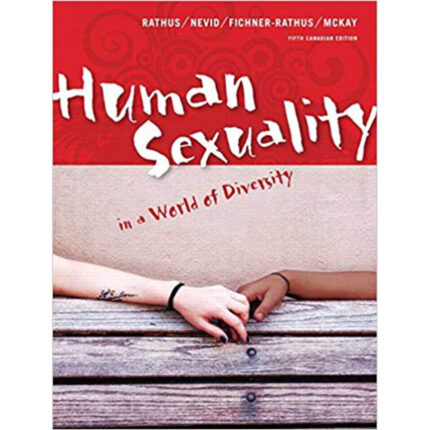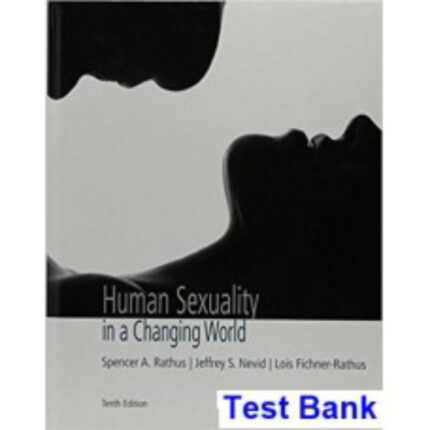Chapter 11
Test Bank
- Based on the mere-exposure effect, you would most likely be attracted to
- A. a person you meet daily and who lives across the hall from you.
- someone you see once in a few years or so.
- someone who lives in a city you visit monthly for office meetings.
- a person you see only on school vacations.
APA Learning Outcome: 1.1: Describe key concepts, principles, and overarching themes in psychology
Accessibility: Keyboard Navigation
Bloom’s: Apply
Difficulty: Medium
Learning Objective: Identify the main theories of physical and psychological attraction.
Topic: Mere-Exposure Effect
Feedback: The Girl Next Door
- The mere-exposure effect refers to the tendency of people to
- look more frequently at people they dislike.
- be attracted to others of the same gender.
- dislike those they see more often in their daily lives.
- D. be attracted to a person they are exposed to repeatedly.
APA Learning Outcome: 1.1: Describe key concepts, principles, and overarching themes in psychology
Accessibility: Keyboard Navigation
Bloom’s: Remember
Difficulty: Easy
Learning Objective: Identify the main theories of physical and psychological attraction.
Topic: Mere-Exposure Effect
Feedback: The Girl Next Door
- Brian is more likely to be attracted to Helen, who lives across the hall from him, than Sharon, who is a friend he sees once or twice a year at parties. This phenomenon is known as the
- A. mere-exposure effect.
- bystander effect.
- matching phenomenon.
- social desirability effect.
APA Learning Outcome: 1.3: Describe applications of psychology
Accessibility: Keyboard Navigation
Bloom’s: Apply
Difficulty: Medium
Learning Objective: Identify the main theories of physical and psychological attraction.
Topic: Mere-Exposure Effect
Feedback: The Girl Next Door
- Sarah sees her childhood friend Brett only once or twice a year during holidays. She sees her colleague Ashton almost every day as they commute to work together. Although Brett and Ashton are quite similar in terms of temperament and behavior, Sarah likes Ashton more than Brett. Which of the following explains this phenomenon?
- cross-race effect
- B. mere-exposure effect
- misattribution of arousal
- matching phenomenon
APA Learning Outcome: 1.3: Describe applications of psychology
Accessibility: Keyboard Navigation
Bloom’s: Apply
Difficulty: Medium
Learning Objective: Identify the main theories of physical and psychological attraction.
Topic: Mere-Exposure Effect
Feedback: The Girl Next Door
- Homophily is the tendency of people to
- be afraid of interacting with people who come from similar backgrounds.
- like people they see frequently.
- C. have contact with people who are equal in social status.
- be attracted to people of the same gender.
APA Learning Outcome: 1.1: Describe key concepts, principles, and overarching themes in psychology
Accessibility: Keyboard Navigation
Bloom’s: Remember
Difficulty: Easy
Learning Objective: Identify the main theories of physical and psychological attraction.
Topic: Homophily
Feedback: Birds of a Feather
- What is the most common type of homophily in marriages in the United States?
- religion
- education
- social class (socioeconomic status)
- D. race
Accessibility: Keyboard Navigation
Bloom’s: Remember
Difficulty: Easy
Learning Objective: Identify the main theories of physical and psychological attraction.
Topic: Homophily
Feedback: Birds of a Feather
- Which of the following variables is the most common type of homophily in marriages and dating?
- A. race
- age
- education
- sexual orientation
APA Learning Outcome: 1.2: Develop a working knowledge of psychology’s content domains
Accessibility: Keyboard Navigation
Bloom’s: Remember
Difficulty: Easy
Learning Objective: Identify the main theories of physical and psychological attraction.
Topic: Homophily
Feedback: Birds of a Feather
- Based on an examination of marriages in which the individuals are similar (Rosenfeld, 2008), which of the following social factors is the LEAST common form of homophily?
- A. religion
- education
- race
- None of the answer choices are correct.
APA Learning Outcome: 1.2: Develop a working knowledge of psychology’s content domains
Accessibility: Keyboard Navigation
Bloom’s: Remember
Difficulty: Easy
Learning Objective: Identify the main theories of physical and psychological attraction.
Topic: Homophily
Feedback: Birds of a Feather
- Karen is a White, upper-middle-class lawyer. She is more likely to have contact with others who are also from the middle and upper-middle class. This phenomenon is known as
- the matching phenomenon.
- B.
- xenocentrism.
- the mere-exposure effect.
APA Learning Outcome: 1.3: Describe applications of psychology
Accessibility: Keyboard Navigation
Bloom’s: Apply
Difficulty: Medium
Learning Objective: Identify the main theories of physical and psychological attraction.
Topic: Homophily
Feedback: Birds of a Feather
10. As an upper-class businessman, Todd has more contact with other businesspeople, lawyers, and doctors he does not meet regularly than with janitors, bartenders, or plumbers. This feature of his social contacts can be explained by the concept of
A. hostile prejudice.
B. homophily.
C. the mere-exposure effect.
D. the contrast effect.













Reviews
There are no reviews yet.